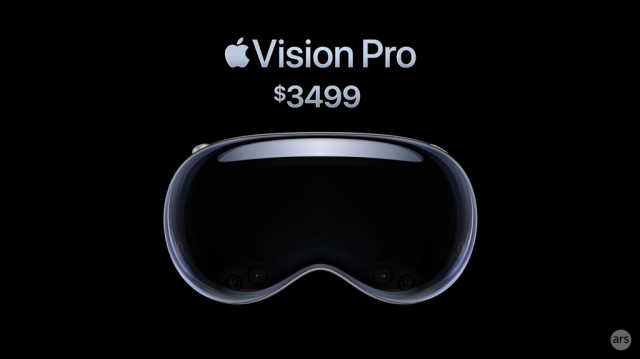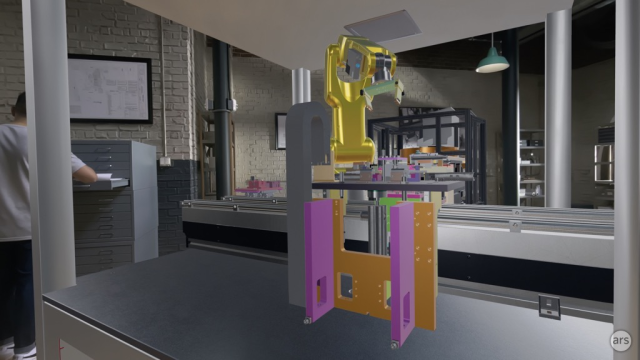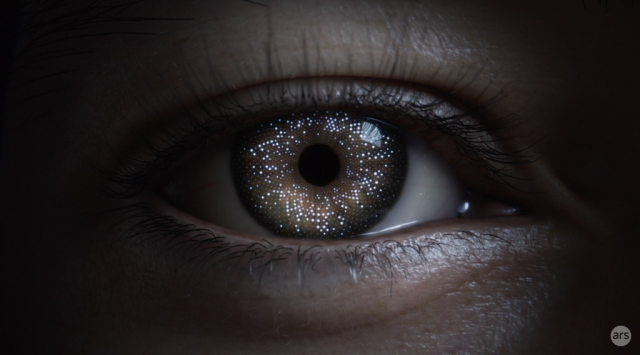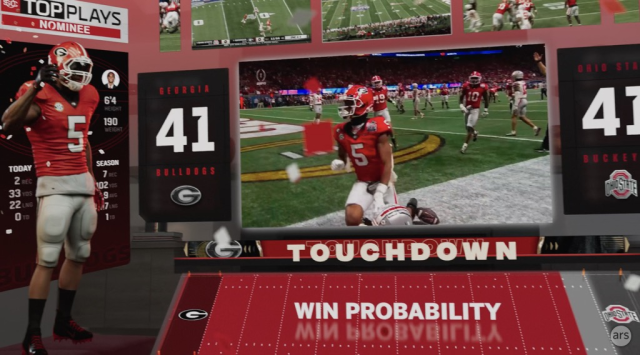
CUPERTINO, Calif.—After years of speculation, leaks, rumors, setbacks, and rumblings of amazing behind-the-scenes demos, Apple has made its plans for a mixed reality platform and headset public. Vision Pro is "the first Apple Product you look through, not at," Apple's Tim Cook said, a "new AR platform with a new product" that augments reality by seamlessly blending the real world with the digital world.
The headset will start at $3,499 and be available early next year. That puts the device in an entirely different class than most existing VR headsets, including the $550 PSVR2 (which requires a tethered PS5 to use) and the $500 Quest 3 that was just announced for a fall release.

"I believe augmented reality is a profound technology. Blending digital content with the real world can unlock new experiences," Cook said.
The headset, which looks like a pair of shiny ski goggles, has a lightweight aluminum frame with a single piece of glass on the front that acts as a lens for a wide array of cameras. A single button lets you capture videos, while a "digital crown" lets you tune how much of outside reality is filtered out at any time.
The Vision Pro's MicroOLED backplane packs 23 million pixels across two panels "the size of a postage stamp." A three-element lens delivers that image at the proper depth "everywhere you look," Apple said, and allows for true 4K HDR video that can show fine text that looks sharp "from any angle."

The headset is powered by an M2 chip combined with support from a new chip called R1. These chips process inputs from 12 different cameras, five sensors (included a LiDAR scanner), and six different microphones. Apple said that while the M2 "ensures performance," the R1 "virtually eliminates lag" and delivers images to the displays within 12ms, ensuring experiences "feel like they're taking place in front of your eyes."

For weight purposes, an external battery will sit in your pocket and connect to the Vision Pro through a cable that attaches to the headstrap near the temple. Apple's product web site says that battery can support "up to 2 hours of use," or all-day use while plugged in to a wall outlet.
A number of "soft textile parts" are part of a modular system that flexes to the form of your face, with a flexible band that incorporates ear pods for sound. Custom inserts from Zeiss will allow for vision correction for those who wear glasses.
The headset's visionOS operating system can be controlled in a "fully 3D interface" without a handheld controller. It solely uses your eyes, hands, and voice as an interface, and the unit lets you "control the system simply by looking." Icons and other UI elements react to your gaze, and you use natural gestures like tapping your fingers or a gentle flick to select them—no need to hold your hands awkwardly in front of you constantly.

Existing iOS developer frameworks have been extended into the visionOS environment to offer support for what Apple is calling "spatial computing." That means "hundreds of thousands" of existing iPad and iOS apps will work on Vision Pro at launch. Apple promises that developers will be able to create 3D objects that "look and feel real" in their visionOS apps. A new app store will include custom Vision Pro apps as well as compatible iOS apps.

A user's encrypted, on-device "Optic ID" is used to unlock the Vision Pro and power things like Apple Pay and password autofill. Camera data and information about your eye input is kept in a separate background process, ensuring that apps and websites can't know where you're looking.
In video demonstrations, Apple showed users walking around and grabbing things from a fridge without taking the headset off. And to further keep you from feeling isolated while wearing the headset, a system called EyeSight will display your eyes when someone is nearby, conveying "a critical indicator of connection and emotion."

Floating 2D apps can be placed to float around your "real world" space, which remains visible through the semi-transparent display. Elements in this interface will cast shadows in the real room around them and respond to light, Apple said. These apps can also "expand fully into your space," like a pulsating 3D animation in a mindfulness app.
A floating 4K Mac display will appear when users glance at their MacBook display while in the Vision Pro. From there, users can interact with a virtual keyboard or their voice to type or make use of a physical Magic Trackpad and/or Magic Keyboard.
While watching movies (including 3D movies) on a virtual floating screen, the device will automatically dim your surroundings to be less distracting. The headset can take spatial photos or videos via "Apple's first three-dimensional camera" with the click of a button. You can then re-experience those 3D panoramas in a way that creates "the sensation they are standing right where it was taken."

Disney CEO Bob Iger came out to demonstrate a number of customized Vision Pro experiences, from Disney+ support to ESPN sports broadcasts with a wide array of stats filling your room to a virtual Mickey Mouse that walks around your space.
Disney+ support will be available on day one, alongside over 100 Apple Arcade titles that will be available to play via a floating screen and a handheld controller on the device.
reader comments
860